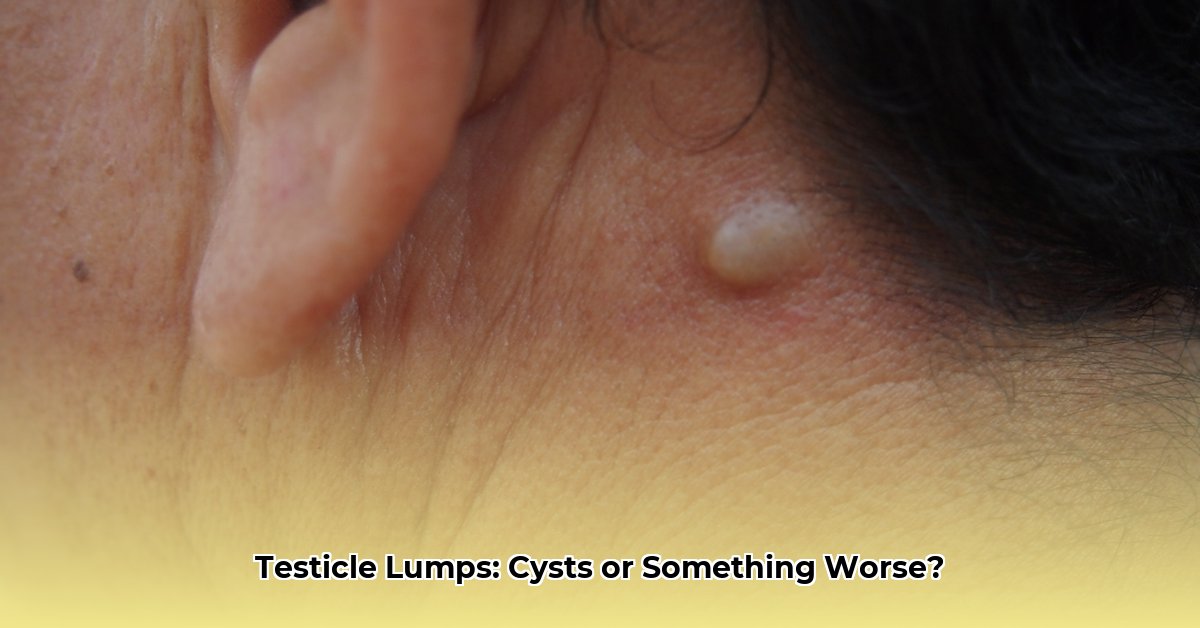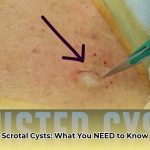Finding a lump on your scrotum can be alarming. While it’s important to have any changes checked by a doctor, a common and generally harmless cause is a sebaceous cyst. This guide provides clear information about scrotal sebaceous cysts, including their appearance, potential causes, and treatment options. We’ll also guide you through testicular self-examination and emphasize the importance of seeking professional medical advice.
Understanding Sebaceous Cysts
What Are Sebaceous Cysts?
Your skin contains sebaceous glands that produce oil (sebum) to keep it moisturized. Sometimes, these glands can become blocked, trapping sebum and forming a small, typically painless lump called a sebaceous cyst. They can occur anywhere on the body, including the scrotum.
Cysts On the Scrotum, Not In It
It’s important to distinguish where these cysts form. Sebaceous cysts develop within the skin of the scrotum, not inside the testicle itself. The scrotum, rich in hair follicles and sebaceous glands, makes it a common location for these cysts. They feel like small, movable lumps under the skin, often resembling a tiny pea or marble.
Why Do They Form on the Scrotum?
Several factors may contribute to blocked glands and cyst formation:
- Buildup of debris: Dead skin cells, dirt, or excess oil can plug the opening of a hair follicle or sebaceous gland.
- Hormonal changes: Fluctuations in hormones might influence sebum production and gland activity.
- Minor injuries or irritation: Skin trauma can sometimes disrupt the normal function of sebaceous glands.
Recognizing a Sebaceous Cyst
What Does it Look and Feel Like?
A scrotal sebaceous cyst is usually a small, smooth, round bump under the skin, easily movable beneath your fingers. They are typically painless but can become tender if infected, potentially accompanied by redness and swelling.
When Should I See a Doctor?
While most sebaceous cysts are harmless and often resolve independently, consult a doctor if you experience:
- Pain or tenderness: Especially if it’s new or increasing.
- Redness or swelling: Indicating possible infection.
- Rapid growth: Unusual or concerning changes in size.
- Drainage or rupture: The cyst leaks fluid or bursts open.
- Multiple cysts: New or numerous cysts appear in the scrotal area.
Although rarely cancerous, any new lump or bump should be examined by a healthcare professional to rule out other conditions.
Diagnosing and Treating Sebaceous Cysts
How is a Sebaceous Cyst Diagnosed?
Doctors usually diagnose a sebaceous cyst through a physical examination. They may also use an ultrasound for a clearer image and to rule out other scrotal issues. Transillumination, shining a light through the scrotum, can help distinguish fluid-filled cysts from solid masses.
Treatment Options
Many sebaceous cysts require no treatment and may disappear on their own. A warm compress can sometimes soothe discomfort and may encourage natural drainage. Never squeeze or pick at a cyst, as this increases the risk of infection.
If a cyst becomes infected, is large, causes bothersome symptoms, or recurs, your doctor might recommend:
- Incision and drainage: A small incision drains the cyst’s fluid.
- Surgical removal: The entire cyst is surgically excised.
Other Scrotal Lumps
Sebaceous cysts aren’t the only type of scrotal lump. Other possibilities include:
- Epidermoid cysts: Similar to sebaceous cysts, but originating from different skin cells
- Ingrown hairs: Small, red bumps, often with a visible hair
- Lipomas: Soft, fatty lumps beneath the skin
- Varicoceles: Enlarged veins within the scrotum (feels like a “bag of worms”)
- Hydroceles: Fluid-filled sacs around the testicle
- Spermatoceles: Cysts containing sperm, attached to the epididymis
- Testicular tumors: Hard, painless lumps on the testicle itself
Important Note: This list is for informational purposes only and is not a substitute for professional diagnosis. Always consult a doctor for any health concerns.
Performing Testicular Self-Exams
Regular self-exams help you become familiar with what’s normal for your body and can help you detect changes early.
- Warm shower or bath: Perform the exam after a warm shower or bath to relax the scrotal skin.
- Gentle rolling: Gently roll each testicle between your thumb and fingers.
- Feel for changes: Note any lumps, bumps, hardness, or changes in size or firmness.
- Note any pain: Pay attention to any pain or discomfort.
(Insert a high-quality image demonstrating the steps of a testicular self-exam)
When to Seek Immediate Medical Attention
While most scrotal lumps are not emergencies, seek immediate medical attention if you experience:
- Sudden, severe scrotal pain
- High fever with scrotal pain or swelling
- Nausea and vomiting with scrotal pain
The Importance of Professional Medical Advice
This information is for educational purposes only and does not substitute professional medical advice. Consult a healthcare provider for any health concerns. Don’t hesitate—early evaluation provides peace of mind and ensures prompt treatment if needed. Your health is worth it.
Disclaimer: This information is intended for educational purposes only and should not be considered medical advice. It is essential to consult with a qualified healthcare professional for any health concerns or before making any decisions related to your health or treatment.
- Water Mill Electricity Generator Provides Free Home Power - December 16, 2025
- Water Wheel Electric Generator Provides Free Home Electricity - December 15, 2025
- Choosing the Right Portable Hydro Turbine for Your Needs - December 14, 2025
















